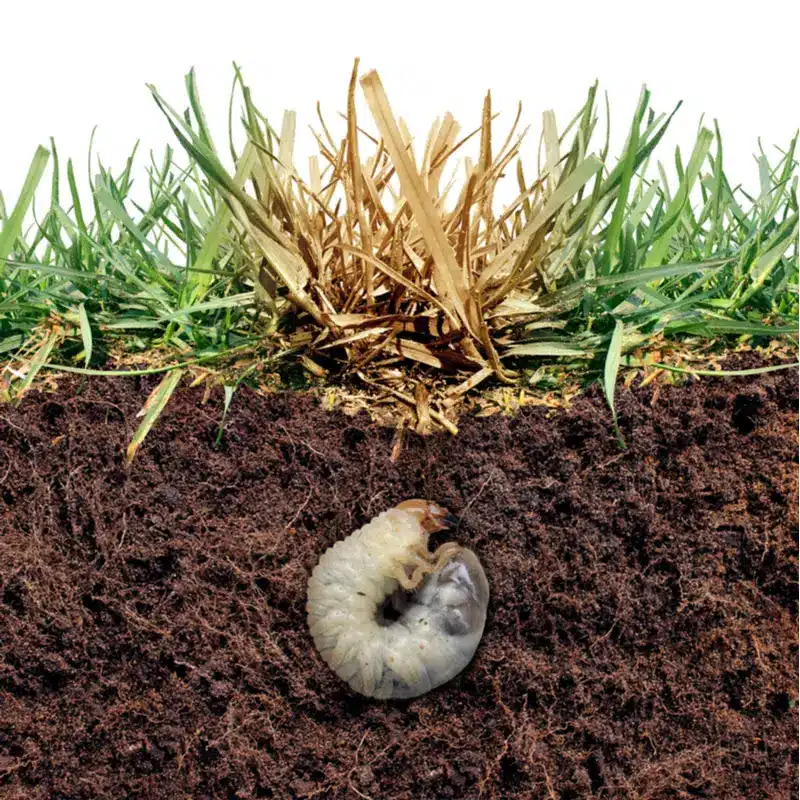
June 21, 2021 | Insect Control | Kylie Kelty
We take pride in our lawns. Not only does having a well-kept landscape add curb appeal, it brings us a sense of stress relief and joy. But achieving thick, emerald green grass takes a lot of time and energy. That’s why the last thing you want to worry about are surface insects destroying your turf. We have tons of things that can damage our grass here in the Louisville area, including climate stressors, fungi, and an array of annoying, gross-looking pests. One of the most devastating and damaging of our fescue lawns is those grass-eating white grubs.
Several species of white grubs can cause destruction, but the most common in Southern Indiana and Kentucky are the larvae of masked chafers and Japanese beetles. They usually show up in late summer around August. Because this is when summer is at its most dry, most of us tend to mistake grub damage for drought. You still have time to get prepared. Learn everything you need to know about grubs and how to prevent them from turning your lawn into a nightmare.
Well, they’re not pretty. Both species have plump, grayish to white bodies with brown heads. They range in size from 3/8 to two inches. They sort of look like a cross between cocktail shrimp and a caterpillar. Perhaps this is because they are slick, shiny, and curled into a C-shape when at rest. They are tiny and hard to see because they bury themselves deep into the roots of your grass. The eggs take anywhere from six to 50 days to hatch before moving on to the next step of larvae. Once they hatch, they begin to feed on your lawn’s roots devouring everything in sight. Even the healthiest and robust greens can fall prone to the devastating damage grubs can cause.
As mentioned, grubs crawl deep into the surface of your lawn and feed on your grassroots. This causes sections of your grass to die. Early symptoms include gradual thinning, yellowing, and weakening of the grass. First, dead patches in your grass show up, then they increase in size and begin wilting. The main symptoms of grub damage include:
Presence of Moles and Other Wildlife
Moles and other wildlife love to feast on grubs as part of their dinner. However, the earthworm is the mole’s main diet and what sustains their lifecycle. Killing grubs will not stop moles. Trapping is the only effective method in managing mole issues.
It’s important to understand the grub life cycle when trying to combat them. In Southern Indiana and Kentucky, they lay their eggs in the late summer/early fall. Therefore, the best time to attack young grubs with pesticides is between June and July. You want to look for a grub control product with carbaryl and trichlorfon listed on the ingredients as these are fast-acting chemicals that kill grubs on contact. If you are looking to go the natural route, you can try a few methods, including nematodes and milky spore.
Nematodes
These are tiny earth-friendly worms about 1mm in length you can use to seek out grubs and kill them naturally. To apply, you need to soak them in water and spray the water onto your lawn. They are effective at combating other soil-bound insects as well.
Milky Spore
A naturally occurring pathogen, milky spore disease (Bacillus popilliae), affects beetle larvae and kills grubs without harming you or your garden. It can, however, take one to three years to become fully effective.
While it’s impossible to eliminate pests altogether, the best way to prevent a grub infestation is to maintain a healthy lawn. Keep your lawn well fertilized with a lawn maintenance program and keep your grass cut between two and a half inches. This will help to promote a healthy root system, which is less prone to a complete takeover by these annoying creatures. Treat dead or dying areas with an overseeding application to restore damaged areas, which will discourage beetles from attacking the stressed grass in the first place.
At Farison Lawn Care, we understand our Louisville climate and the pests that damage our lawns. We offer an effective grub control that we apply in the summer to help prevent and combat these grass-eating critters. With Farison, you don’t have to waste time trying to prevent or combat pests like grubs on your own. Our trained and knowledgeable staff has you covered. We also offer a highly effective lawn care program for the care and maintenance of your lawn. Sustaining a healthy lawn is the most important thing any home or business owner can do for their yard. Strong, durable roots are better able to stand up to pests, including grubs and all other insects and diseases. Learn more about either of these programs by calling us today. You can reach us at 502-245-9422 or contact us right here.
For more tips and ideas on lawn care, tree care, and pest control, check out our other blog articles. To get to know us better as a company and follow our latest deals, connect with us on social media. You can like us on Facebook and follow us Instagram. And check out some of our latest projects via our YouTube channel!
love what we do?